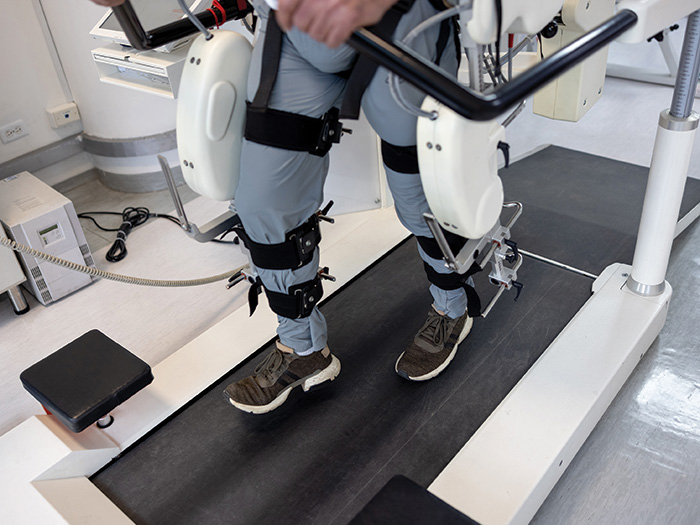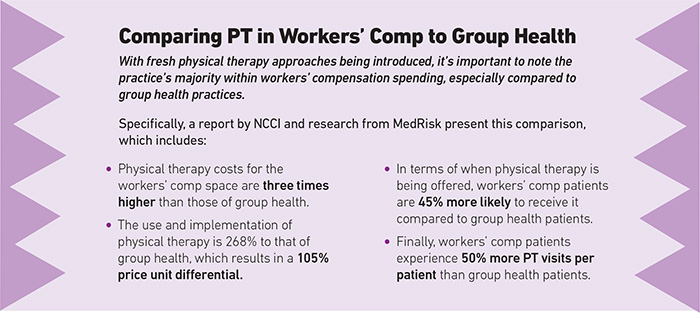Why These Novel Physical Therapy Strategies Are Getting Attention from Workers’ Comp

Physical therapy occupies a larger portion of the workers’ compensation medical spending pie than ever before, and its effectiveness is well-established for musculoskeletal injuries.
But strategies to optimize it are almost as numerous as adjusters authorizing physical therapy.
As machine learning and tracking technology increasingly influences everyday decisions of claims professionals though, the industry is taking new steps to ensure that the fundamentals are done right.
From an operational perspective, leaders want their staff to cut out the noise.
“Rather than assuming that what’s on the script is what needs to be done, there has to be some review of the appropriateness,” said Mary O’Donoghue, COO of MedRisk.
Melissa Burke, vice president and head of managed care & clinical at AmTrust Financial agreed.
“Our ideal management of a PT program requires transitioning from looking at PT as a commodity where you’re looking at transactional cost, to really taking a deeper dive and looking at our utilization of physical therapy to ensure that it’s started appropriately, continued appropriately, and that the timeline and need are aligned with the actual injury that’s compensable,” she said.
All About the Technology

Melissa Burke, vice president and head of managed care & clinical, AmTrust Financial
These types of screening and assessment methods are increasingly dependent on technology.
“We partner, particularly with our largest providers, to collect their outcome data on a regular basis. We meet with them and we go through the outcomes on all of our referrals. We’re all trying to do the same thing — get that injured worker back to work as quickly as is medically appropriate,” O’Donoghue explained.
In pursuit of that goal, workers’ compensation professionals turn to clinical expertise within their ranks — allowing those closest to patient care to educate frontline claims staff and injured workers on physical therapy’s benefits.
Adam Pehr, vice president of clinical services at Concentra, explained that the relationship formed between claims, clinical and ancillary providers can make all of the difference.
“Our physicians often walk the injured worker back over to therapy and establish a warm handoff to establish a trust between the patient, the therapist and the clinician that their needs will be taken care of efficiently and effectively,” he said.
Results and Benefits
Once that quick turnaround results in treatment, the results speak for themselves.
Optum medical director, Robert Hall, described early physical therapy benefits as falling into three buckets, which he believes are apparent as the injured worker takes accountability for their role in the recovery process.
First, the benefit associated with getting up and moving at all, and second and thirdly, medication use and re-injury reduction.
“We all know that injuries can result in any type of pain medication, whether it’s anti-inflammatories all the way to opioids,” Hall said.
“With the benefits that early PT can have on pain control, that also helps hopefully reduce the amount of opioids. It helps prevent re-injury or another injury down the road, because if somebody does have, for example, an ankle sprain, that can make their ankle feel weak and less supportive, and it can also put that person at risk for another ankle sprain down the road or even hurting the one that’s already injured.”
Research from the Workers Compensation Research Institute (WCRI) bears this out.
A 2020 study focusing on 26,000 low-back-pain-only claims indicates that early physical therapy intervention can not only improve injured worker outcomes first and foremost but can also lower temporary disability duration significantly.
The researchers noted that later timing (defined as greater than 30 days post-injury) resulted in a 58% longer than average number of temporary disability weeks per claim.
Importantly, opioid prescriptions also skyrocketed after the month post-injury inception of PT — this cohort of workers were 46 and 47% more likely to receive opioid prescriptions and MRI, respectively.
“Data shows physical therapy can prevent overuse of imaging modalities or unnecessary surgeries resulting in better outcomes for the patient and less money spent,” said Dr. Carrie Stewart, physical medicine rehabilitation specialist at Carisk.
“This is advantageous from both a patient and payer perspective. There may be some instances where physical therapy is overutilized, however, this is rare.”
In terms of claim costs, overuse of imaging remains a significant concern, which has only broadened in the last decade.
One 2013 study found that the 37% of the non-specific low back pain cases that received early MRI “had similar outcomes regardless of radiculopathy status, much lower rates of going off disability and, on average, $12,948 to $13,816 higher medical costs than the no-MRI groups.”
Don’t Celebrate Just Yet
Regardless of the potential benefits for outcomes and overall costs associated with PT, and especially early PT, scrutiny remains necessary.
“What’s being ordered can’t just be the path of least resistance. It needs to be the path that is going to help that injured worker most effectively,” said Michelle Despres, vice president of product management at One Call.
This is one area where technology can assist claims professionals with right-sizing the number of visits and even the chosen provider.
One Call uses a scoring system, like some other vendors, that enables them to provide their clients with various facets of a practitioner’s performance metrics.
“We highlight who does the best job clinically and is compliant with administrative tasks that are aligned with the payer, ensuring everything runs smoothly,” Despres explained.
Bardavon Health Innovations chief clinical officer, Dorothy Riviere, is also putting tech at the forefront of physical therapy management.
The company specializes in physical therapy for workers’ comp and has developed multiple models to manage it.
“AI and predictive analytics have advanced substantially,” Riviere said.
“Bardavon has created, and we’re now validating, a personalized utilization prediction model, which predicts the expected number of visits necessary for a patient after the initial evaluation of a patient. That allows for each injured worker’s utilization to be considered individually.”
This technology is set to go to market soon; Bardavon is 80% through the validation process.

Tate Rice, director of product management, Healthesystems
Wider industry research appears to capture the necessity of adopting new technologies like artificial intelligence as it is deployed across the occupational health sector.
A 10-year study examining how AI could be applied to workers’ compensation claims data in order to identify ergonomic and safety priorities was awarded for excellence by NIOSH in 2017.
David Huth, PMA Companies’ VP of managed care, is also employing tech to optimize PT’s role by looking at the claim’s overall risk.
“The tool we’ve used that’s really making a difference is upfront data driven risk scoring,” he said. “As new claims come, it identifies the higher risk claims and those that would potentially benefit from a course of PT. We have automated risk analysis at claim intake and that runs continuously as the claim progresses.”
And they’re in good company. Brian Nichols, CorVel’s VP of network solutions, also pointed to his organization’s risk assessment and data capture capabilities as a major value-add element of its work.
“Some of the risk factors we use and how we use them is relatively proprietary, however the results are clear. In regards to CorVel’s physical therapy management program, we’ve seen year-over-year reductions in program-wide PT visit usage for seven consecutive years. During that same time, industry data shows year over year increases,” he said.
The Industry’s Worth
Continual risk assessment counts itself among the many decisions that frontline claims staff make on a daily or weekly basis for every case they handle, and as caseloads skyrocket across the insurance writ large, some companies are stepping into the fray to reduce the fatigue and human error.
“Claims professionals are overwhelmed. They carry such a high volume of decisions that they need to make in a day. If you see in isolation one day may not be that big of a deal, but when it’s every day, that’s a different story,” Tate Rice, Healthesystems’ director of product management, explained.

“I think what we need to do a better job of is unburdening them and taking those easier, more obvious authorization or no authorization decisions off of their shoulders. We can do that by capturing that unstructured data to drive better injury care.”
No matter what the method, ultimately, it’s the injured worker who determines the level at which PT can produce better outcomes.
As the advocacy-based care model becomes commonly accepted wisdom across the board, the industry’s role in limiting friction and proving their systems’ worth is ever more apparent. &










